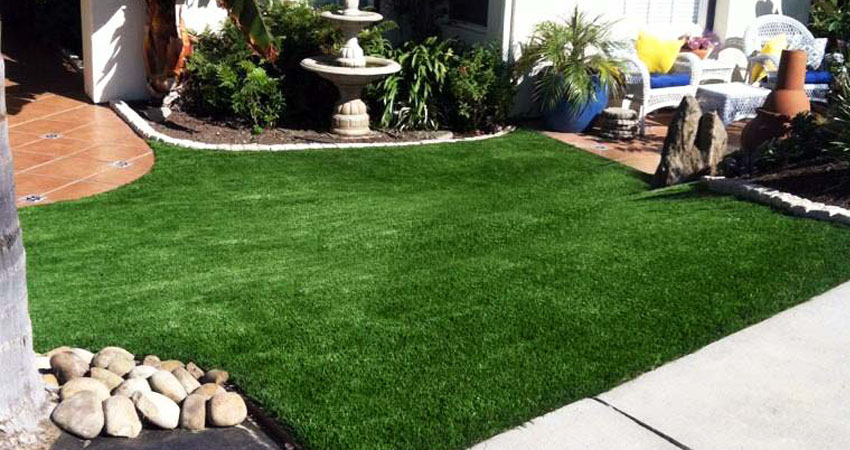An artificial lawn may be the best choice for your family’s needs. Today’s artificial lawns are incredibly lifelike but require maintenance to look their best.
How is Artificial Turf Made?

Artificial turf has been in use for 60 years. It was first used in football stadiums. Makers of artificial turf spent 30 years improving it based on feedback from sports teams. Today’s artificial turf looks and feels like real grass, and is available in a variety of grass “species.”
The backing used in the highest quality artificial turf is little different from the tires on your car. It’s tough and weather-resistant. It does deteriorate over time like a car tire, but it’s easy for a landscaper to replace sections as they age.
The blades of top quality artificial grass are made from nylon cut into the same shape, width and length as the grass of the ideal lawn. The middle layer between the grass and the base is designed to provide a cushioned surface for walking, sports and children at play. Every element down to the thread that pulls the elements of a section of artificial turf together is designed for strength, longevity and a natural appearance.
Why Choose an Artificial Lawn?
The main reason to choose an artificial lawn is to avoid mowing grass. Other reasons to go with artificial turf are:
• Consistent color and texture
• No watering needed
• It’s great for high traffic areas
• No bare or thin spots
• It looks natural edged with live plants
Artificial lawns bear up well under the natural activities of families with children and pets. Your children can play in the same area every day without killing grass and leaving you with an unattractive area of dirt, and synthetic turf will never yellow after the family dog visits it.
Maintaining Your Artificial Lawn
All landscaping, including hardscapes, rock gardens and artificial laws require maintenance to keep them looking their best. Artificial turf in particular requires care to preserve its realistic and clean appearance.
Artificial lawns are built on top of existing lawns made up of dirt and all the fauna and flora that live in dirt. Your landscaper will level and smooth your yard before installing artificial turf. Depending on UV light damage, physical wear and tear and weather, your artificial lawn will require replacement to preserve its beauty.
How can you extend the life of your artificial lawn? You can maintain your lawn by:
• Weekly cleaning with water
• Monthly raking
• Immediately picking up after pets
• Contacting your landscaper for unusual cleanups
• Contacting your landscaper for weed/mold/mildew issues
Rinsing down your lawn is like sweeping your floors. Raking is like vacuuming. Cleaning up after each pet visit to the lawn is just common sense.
The landscaper who installed the turf should handle oil spills and other chemical spills.
Weeds and fungi growths are signs that your synthetic turf is deteriorating.
Things to Remember:
• Artificial lawns are low maintenance, not no maintenance
• Today’s artificial turf feels and looks like real grass
• You can incorporate live plants into an artificial lawn
The best time to install your artificial lawn is early spring, so contact us today.
